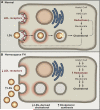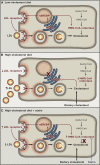A century of cholesterol and coronaries: from plaques to genes to statins
- PMID: 25815993
- PMCID: PMC4525717
- DOI: 10.1016/j.cell.2015.01.036
A century of cholesterol and coronaries: from plaques to genes to statins
Abstract
One-fourth of all deaths in industrialized countries result from coronary heart disease. A century of research has revealed the essential causative agent: cholesterol-carrying low-density lipoprotein (LDL). LDL is controlled by specific receptors (LDLRs) in liver that remove it from blood. Mutations that eliminate LDLRs raise LDL and cause heart attacks in childhood, whereas mutations that raise LDLRs reduce LDL and diminish heart attacks. If we are to eliminate coronary disease, lowering LDL should be the primary goal. Effective means to achieve this goal are currently available. The key questions are: who to treat, when to treat, and how long to treat.
Copyright © 2015 Elsevier Inc. All rights reserved.
Figures





References
-
- Abifadel M, Elbitar S, El Khoury P, Ghaleb Y, Chémaly M, Moussalli M-L, Rabès J-P, Varret M, Boileau C. Living the PCSK9 adventure: from the identification of a new gene in familial hypercholesterolemia towards a potential new class of anticholesterol drugs. Curr. Atheroscler. Rep. 2014;16:439–461. - PubMed
-
- Abifadel M, Varret M, Rabes J-P, Allard D, Ouguerram K, Devillers M, Cruaud C, Benjannet S, Wickham L, Erlich D, Derre A, Villeger L, Farnier M, Beucler I, Bruckert E, Chambaz J, Chanu B, Lecerf J-M, Luc G, Moulin P, Weissenbach J, Prat A, Krempf M, Junien C, Seidah NG, Boileau C. Mutations in PCSK9 cause autosomal dominant hypercholesterolemia. Nature Genetics. 2003;34:154–156. - PubMed
-
- Alberts AW, Chen J, Kuron G, Hunt V, Huff J, Hoffman C, Rothrock J, Lopez M, Joshua H, Harris E, Patchett A, Monaghan R, Currie S, Stapley E, Albers-Schonberg G, Hensens O, Hirshfield J, Hoogsteen K, Liesch J, Springer J. Mevinolin, a highly potent competitive inhibitor of HMG-CoA reductase and cholesterol lowering agent. Proc. Natl. Acad. Sci. USA. 1980;77:3957–396l. - PMC - PubMed
-
- Anderson RGW, Brown MS, Goldstein JL. Role of the coated endocytic vesicle in the uptake of receptor-bound low density lipoprotein in human fibroblasts. Cell. 1977;10:351–364. - PubMed
-
- Anitschkow N, Chalatow S. Ueber experimentelle cholesterinsteatose und ihre bedeutung für die entstehung einiger pathologischer prozesse. Zentralbl. Allg. Pathol. Anat. 1913;24:1–9.
Publication types
MeSH terms
Substances
Grants and funding
LinkOut - more resources
Full Text Sources
Other Literature Sources
Medical

